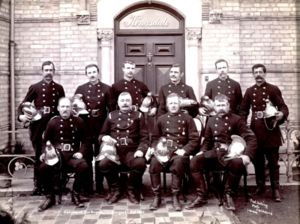Great Fire of 1912: Difference between revisions
Bob Moncrief (talk | contribs) m (FA Nomination template) |
No edit summary |
||
| Line 1: | Line 1: | ||
__NOEDITSECTION__ | __NOEDITSECTION__ | ||
{{FANom}} | {{FANom}} | ||
[[Image:1912FireEngine.jpg|thumb|300px|right|One of the new additions to the brigade which proved invaluable during the crisis]] | [[Image:1912FireEngine.jpg|thumb|300px|right|One of the new additions to the brigade which proved invaluable during the crisis]] | ||
Revision as of 18:45, 2 September 2012

|
Featured Article Nominee |
| This article has been nominated for Featured Article status. Please go to the Featured Article candidacy page and discuss the page's nomination. |
The Great Fire of 1912 was a major conflagration that swept through a large area of Malton. It included several accidental, deliberately lit and initially localised blazes, and lasted from Thursday the 15th of August to Saturday the 24th of August, 1912.
Initial Outbreaks
Due to the spectacular fame of the Great Fire, prior to 2005 it was known as Malton's worst disaster. A variety of groups, organisations and locations have made claims on starting the original Great Fire. The simple fact of the matter is that due to a handful of bizarre coincidences (and potential planetary alignments), several fires broke out across Malton simultaneously. Locations that are reputedly home to the initial blaze that caused the real Great Fire of 1912 include:
- Bacon Row: Drunks hungry for revenge (and bacon, apparently) were blamed by some for causing at least a localised blaze.
- Cocker Boulevard Fire Station: Incompetent firefighters and their poorly-thought-through experiments may also have been a major contributor to the tragedy.
- The Every Building: Location of miscommunication in its deadliest form.
- Wine Place: Oh the irony! Substandard demolition results in a Great Fire, but was it the Great Fire?
- Cade Place Fire Station: When it comes to Fire Station rivalry, no one wins.
- 2 Cola: A night celebrating the discovery of the perfect cola recipe went horribly wrong.
Becoming the Great Fire
One of the reasons the fire spread unchecked was the current state of Malton's fire departments. Large businesses and the more kindhearted councilmen maintained private fire departments, but they were all independent and lacked any form of cohesion. When the first flames rose above Malton the first two fire teams on the scene, from Headland Street and Cocker Boulevard, came to blows over who would extinguish the blaze. Two further teams were sucked into this melee, before the highly efficient fire team 9, sponsored by The Alner Family, arrived on the scene with their state-of-the-art water pumping carriage.
Some less fortunate firemen paid a high price for this competitiveness. Members of the Cade Place team were trapped inside their own building by a number of carts placed there by the ever-enthusiastic Getsom Drive Fire Station team, who wanted the glory of fighting the fire to be all theirs. When the fire spread unchecked, only 3 firemen survived the building's destruction. A memorial still stands on the site to remind the residents of Malton of the sacrifice these nine brave souls paid in an attempt to keep Malton safe.
By this point, the fire had spread beyond the initial sites and was uncontrollable, seemingly spreading to every building in Malton.
Religious Outfall
Prior to the fire around 30% of Malton was Christian, with only a negligible number of members of other religions. However, the extent of the fire, and the fact that locations on the list of Amusing Locations in Malton were seemingly 'targeted' by the fire, would soon change this.
After the passing of the fire, the Church declared the list to be evil and a work of the devil, clearly evident in the fact that God had targeted its locations when unleashing judgment upon the sinners of Malton. After this announcement citizens of Malton immediately went on a witch hunt, burning many locations on the list that had not been destroyed and slaughtering the contributors to the list. Fearing for their own lives, or perhaps caught up in the religious frenzy sweeping Malton, Maltonians rushed to join Churches in record numbers. This resulted in the construction of many new churches and Cathedrals across the city.


